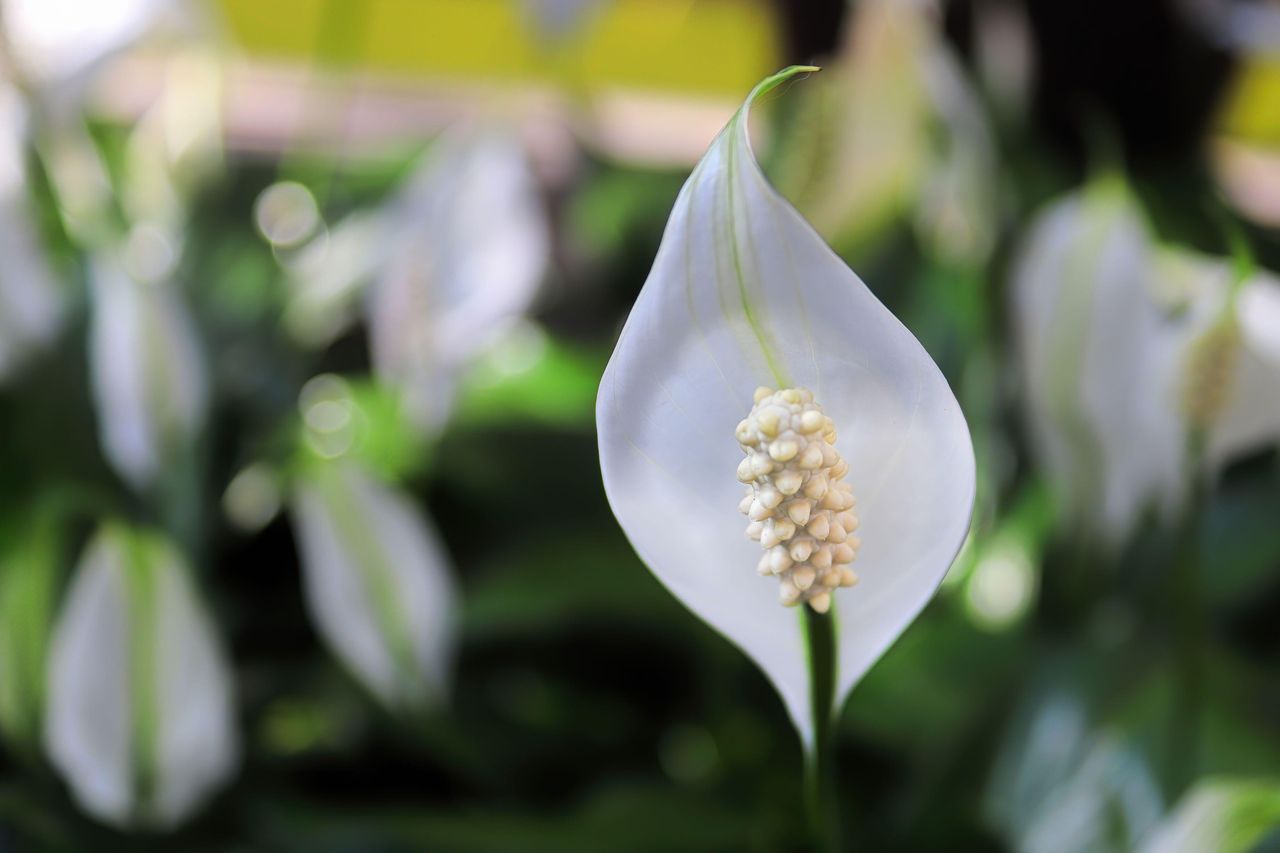Peace lily care – how to grow peace lilies successfully
Knowing how to care for peace lilies properly will ensure abundant growth and healthy, glossy leaves


Caring for peace lilies will ensure these wonderful house plants thrive in your home. Known for being adept at cleaning the air, their glossy green leaves and occasional curvaceous blooms – actually leaf bracts, but eye-catching nonetheless – make them perfect for living rooms, home offices and bedrooms.
Peace lilies should be grown indoors unless you live in a warm, humid climate – such as zones 10 and 11 where peace lilies can be grown outdoors. Get peace lily care right and the typical house plant cultivar can reach up to 16 inches tall indoors.
Growing peace lilies is pretty easy, but you do need to care for them in a particular way for them to stay healthy. Below, we take you through everything you need to know about peace lily care so that your winter house plants look good right through to summer.
Peace lily care
Peace lilies (Spathiphyllum), sometimes also called 'closet plants' because they can grow well in low light, are an excellent house plant – and not difficult to care for. That said, caring for peace lilies properly will ensure they grow healthily.
Does peace lily need sunlight?
Peace lilies don't need direct sunlight. In fact, peace lilies prefer indirect or dappled sunlight, so while you can put them in a bright corner, they will also enjoy low to medium light, too. Bear in mind, though, that peace lilies grown in light rooms are more likely to produce the white 'flowers' than those that are grown in lower light.
Where should I place a peace lily in my house?
A peace lily's natural habitat is the forest floor, which means they prefer humid atmospheres, such as bathrooms and kitchens, over dry rooms – such as living rooms with roaring log fires. That said, they will be happy in drier rooms if you care for them properly, such as misting their leaves. Peace lilies also prefer dappled or indirect sunlight over direct sunlight. Get the conditions just right and they will also produce their pretty white bracts – or flowers.
How often should I water my peace lily?
Peace lilies like consistent moisture in the atmosphere, but that doesn't mean they need to be over-watered. Instead, water peace lilies when the top inch or so of the soil in their pots is dry or when their leaves start to visibly droop – this won't damage them long-term and is a good way to avoid over-watering them, which can kill them. The aim is to keep the soil moist but not wet.
Peace lilies kept in dry rooms will need watering more often than those kept in humid rooms, and will need misting every now and then, too – the drooping leaves are a useful signal for you to water them. Another option is to sit the peace lily's pot in a dish of garden pebbles and water to promote local humidity.
Should I feed a peace lily?
Peace lilies don't need feeding often, though you can fertilize a peace lily with some house plant fertilizer to their water (following the manufacturer's instructions) every two to three weeks in spring and summer.
Should I deadhead my peace lily?
Sometimes peace lilies' leaves turn brown or yellow, or get bent by someone passing by. Once this happens, it is best to snip off the dying or dead leaves – or bracts – at the base of the plant. You may also want to trim off leaves to keep a neat shape for your peace lily. Wash your scissors before using them to cut another house plant, just in case your peace lily has a disease that could be passed on. You should also deadhead peace lilies after flowering to encourage returning blooms.
Should I repot my peace lily?
Peace lilies don't mind having restricted roots, but if yours begins to droop, and doesn't respond to watering, or if or the leaves are growing in irregular shapes, these could be signs that your plant needs repotting.
To get the best of repotting a peace lily, find a pot that's about a third larger than the peace lily's root ball; add house plant compost to around two-thirds of the pot's height, place the rootball and fill around it with compost. Firm the soil down, water and leave until it needs watering again.
You can divide peace lilies if you want to create two plants from one: simply cut through the center of the rootball with a sharp knife, and plant each, following the instructions above.
My peace lily's leaves are dusty – what should I do?
Peace lilies' leaves do attract dust, especially in open-plan kitchen diners, where the stickiness produced by cooking can make the dust problem worse. Dust and grime does need removing from peace lilies' leaves – and from other house plants' leaves – because it stops the plant from photosynthesizing well.
The best way to remove dust from peacy lily's leaves is to put the plant into the bath or shower and gently running the showerhead over it (ensuring the any excess water can drain out of the bottom of the pot). Or, you can simply take a damp cloth and wipe down the leaves when you are dusting the rest of your room.
Why does my peace lily have yellow leaves?
A peace lily may have yellow leaves for many reasons – perhaps that leaf is just old, or got bent, perhaps the plant is sitting in a draft, is being blistered by direct sunlight, or is being over- or under-watered.
Once the peace lily's leaves are yellow they won't go back to being green. So, the best thing to do is to prune your peace lily, by snipping them off at the base of the plant and disposing of them.
Why are my peace lily's tips brown?
Peace lilies' leaves turn brown for a number or reasons, the most common being that they are being over- or under-watered, over-fertilized or because the water you are watering them with has high salt content. Or, perhaps they are too near a heat source, whether sunlight or home heating.
You cannot reverse the damage – it is better to remove dying leaves and to place the plant in a position where it will be happier: in dappled shade or indirect sunlight in a room that's humid and warm, rather than dry and drafty. Then, only water the plant when the leaves signal it's thirsty by drooping.
My peace lily is drooping – what should I do?
Peace lillies' leaves droop when it is thirsty – and in fact, if you aren't in the habit of checking its soil to see if it's dried out sufficiently, this is the best way to tell if your plant is thirsty. If the leaves of a peace lily droop, water it, then wait. If the leaves recover again with a few hours, all is good with the plant and you just need to wait for them to begin to droop again before re-watering. If, however, watering doesn't reverse the droop, your plant is likely signalling to you that it needs repotting.
If you have toddlers or animals who tend to nibble on your house plants, be aware that peace lilies will cause sickness and swelling in the tongue if eaten.
Sign up to the Homes & Gardens newsletter
Design expertise in your inbox – from inspiring decorating ideas and beautiful celebrity homes to practical gardening advice and shopping round-ups.

Lola Houlton is a news writer for Homes & Gardens. She has been writing content for Future PLC for the past six years, in particular Homes & Gardens, Real Homes and GardeningEtc. She writes on a broad range of subjects, including practical household advice, recipe articles, and product reviews, working closely with experts in their fields to cover everything from heating to home organization through to house plants. Lola is a graduate, who completed her degree in Psychology at the University of Sussex. She has also spent some time working at the BBC.
-
 Is this the quietest coffee machine I've ever tested? My KitchenAid KF6 review
Is this the quietest coffee machine I've ever tested? My KitchenAid KF6 reviewSpoiler alert: yes, it's silent, sturdy and super stylish
By Lydia Hayman Published
-
 Experts reveal 5 surprisingly toxic items in your home to get rid of now – and what to replace them with
Experts reveal 5 surprisingly toxic items in your home to get rid of now – and what to replace them withCurate a healthier home by ditching these toxic items
By Chiana Dickson Published